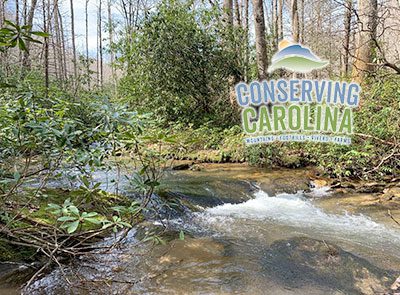
Land Protection Director Tom Fanslow says, “The Polchow family exemplifies a superb conservation ethic and community spirit. Their sacrifice of development rights ensures our community will continue to enjoy safe, high quality drinking water.”
The 694-acre property encompasses an entire sub-watershed containing nearly seven miles of pristine streams, headwater seeps, and springs that form Tarkiln Branch, a tributary of Cathey’s Creek. In addition to protecting the public water supply for the City of Brevard, this private conservation land protects Pisgah National Forest from encroaching development. The property is surrounded on three sides by the national forest and it shares a 4.5-mile border with the forest. It’s a place of crystal-clear streams, brook trout, salamanders, rare wildflowers, and tall trees.
The land is owned by three Polchow siblings — Richard, Elizabeth, and one other sibling. Richard Polchow says that his parents originally purchased the land with conservation in mind. They bought the Cathey’s Creek property in 1963, when he was in middle school. The family lived in New Orleans but the kids went to summer camp in the mountains and the family would stay at Kanuga Conference Center. “We fell in love with the mountains,” he says.
His parents, Robert (Bob) and Mary Polchow, went on to purchase land in Henderson and Transylvania Counties. “We never contemplated any subdivision or selling off the property,” Polchow says. “Conservation was the primary goal.”
A family friend, Al Moore, who led hikes and adventures at local summer camps, connected them to the mountains in a unique way. Polchow says, “I’m fortunate to have known people who loved the land and helped to educate me about the value of the mountain land, particularly Al Moore.”
Moore was a Brevard native with a deep knowledge of the mountains, who cherished the old mountaineers, Polchow says. For innumerable campers and for the Polchow family, Moore inspired a love for the nature, culture, and history of this region. “He lit the fire for conservation,” Polchow says.
The Cathey’s Creek land also benefited from the management of the previous owner, Walter Weilt. He logged the land once, in the late 1940s, but selectively, leaving all trees above 12 inches in diameter. He also logged without heavy machinery, hauling the logs out with horses and mules. “The land was really taken care of,” Polchow says. “It was never abused like some tracts, where it was clear cut and wasted.”
Today, the forests have been growing uninterrupted for over 70 years. And, the conservation easements ensure that they will not be logged in the future. While many conservation easements do allow agriculture or forestry, the easements on the Polchow’s land are designed to offer the strongest possible protection for the watershed. Future forestry management is strictly limited to forest preservation.
Polchow says, “My goal is: Let’s have Joyce Kilmer all over again.” When he was a boy, a year after his parents bought Cathey’s Creek, he went camping in Joyce Kilmer Memorial Forest and was awed to see the towering old growth forest. He says, “The Cathey’s Creek forest isn’t old growth but it’s getting there. It’s destined to be that again.”
Tom Fanslow, Conserving Carolina’s Land Protection Director, points out that conservation easements are tailored to help private landowners achieve a range of goals. In addition to protecting their land, those goals might include generating income, making a living from the land, reserving limited development rights, or passing property on to the next generation.
For a portion of this property, Equinox Environmental facilitated the easement by setting up a stream preservation mitigation bank. The streams protected under the mitigation bank will offset permitted impacts to streams elsewhere in the French Broad River watershed. The Polchow family also generously donated an easement on two upland ridges that surround but are not included in the mitigation bank.
Owen Carson, Botanist & Senior Ecologist at Equinox, reflects on the experience: “Working on this project with the Polchow family over the past four years has been a dream come true. In walking each of the nearly 36,000 feet of stream, traversing the slopes and ridges between, and discovering countless wild treasures hidden amongst old trees, my team and I have been truly humbled by the property’s diverse natural and cultural heritage.”
Equinox’s efforts to help the Polchows find a conservation solution began in 2017, and were spearheaded by former vice president Steve Melton, who tragically and unexpectedly passed away in the spring of 2018. “He’d be so proud of how this project turned out,” Carson says.
The land newly protected in the Cathey’s Creek watershed brings the amount of land protected by Conserving Carolina in 2021 to approximately 1,047 acres. Conserving Carolina has now protected a total of over 47,000 acres, primarily in Henderson, Transylvania, Polk, and Rutherford Counties.